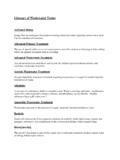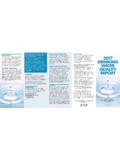Transcription of Biochemical Oxygen Demand
1 UNESCO EOLSSSAMPLE CHAPTERSENVIRONMENTAL AND ECOLOGICAL CHEMISTRY Vol. II Biochemical Oxygen Demand - Michael R. Penn, James J. Pauer, James R. Mihelcic Encyclopedia of Life Support Systems (EOLSS) Biochemical Oxygen Demand Michael R. Penn University of Wisconsin-Platteville, Wisconsin, USA James J. Pauer Welso Federal Services, US EPA Large Lakes Research Station, Grosse Ile, Michigan, USA James R. Mihelcic Michigan Technological University, Houghton, Michigan, USA Keywords: Biochemical Oxygen Demand , biological Oxygen Demand , chemical Oxygen Demand , biodegradability, biodegradation, dissolved Oxygen , dissolved Oxygen sag curve, wastewater treatment, surface water, water quality, modeling, nitrification, BOD, NBOD, EPA, OECD Contents 1.
2 Introduction 2. Theory Five-day BOD (BOD5) Ultimate BOD (UBOD) Carbonaceous Oxygen Demand (CBOD) Nitrogenous Oxygen Demand (NBOD) 3. Measurement Requirements Limitations 4. Typical values for waters and wastewaters Domestic wastewater Industrial and Commercial wastewater Stormwater Surface Waters Specific Organic Compounds 5. Alternatives Chemical Oxygen Demand (COD) Theoretical Oxygen Demand (ThOD) Relationship Between COD and ThOD Relationship Between BOD and COD 6. Applications Surface Water Quality Modeling wastewater Treatment Modeling Acknowledgments Glossary Bibliography Biographical Sketches UNESCO EOLSSSAMPLE CHAPTERSENVIRONMENTAL AND ECOLOGICAL CHEMISTRY Vol.
3 II Biochemical Oxygen Demand - Michael R. Penn, James J. Pauer, James R. Mihelcic Encyclopedia of Life Support Systems (EOLSS) Summary Biochemical Oxygen Demand (BOD) is a measure of the dissolved Oxygen consumed by microorganisms during the oxidation of reduced substances in waters and wastes. Typical sources of BOD are readily biodegradable organic carbon (carbonaceous, CBOD) and ammonia (nitrogenous, NBOD). These compounds are common constituents or metabolic byproducts of plant and animal wastes and human activities (domestic and industrial wastewaters). The discharge of wastes with high levels of BOD can cause water quality problems such as severe dissolved Oxygen depletion and fishkills in receiving water bodies.
4 Standardized methods for the quantification of BOD in wastewaters have remained virtually unchanged for decades despite numerous shortcomings. Alternative techniques and estimation methods have been proposed. The kinetics of dissolved Oxygen consumption resulting from BOD discharges have been formulated into several mathematical models for simulating surface water quality. The long history of the BOD test and its incorporation into many major water quality models ensures that it will continue to be measured for decades in the future. 1. Introduction As the populations of many cities grew significantly larger during the late 19th Century due to industrial expansion, sewer systems were installed to transport domestic wastewater (from toilets, washing, etc.)
5 And industrial wastewater to rivers or other surface waters for disposal with little or no treatment (see Water Quality, Chemistry of wastewater , Thermal Pollution of Water). Primary wastewater treatment, that employed only sedimentation basins, removed large debris and readily settleable solids; however, the majority of the organic material was not removed because it was either dissolved or of low density so that it settled slowly. Thus, as human populations increased, so did the loading of organics to the nearby surface waters. The increased organic loading stimulated microbial decomposition that utilized dissolved Oxygen (DO) in the surface water. This consumption of DO and attendant DO depletion in many cases led to the development of anaerobic conditions that could not support desired aquatic life, such as fish, and also caused aesthetic water quality problems (see Eutrophication and Algal Blooms).
6 Advanced (secondary) wastewater treatment was then introduced to biologically remove the organic matter to alleviate this problem. The depletion of dissolved Oxygen thus became a primary water quality concern after more important priorities such as disinfection (pathogen destruction) were addressed. During the period from 1950 to 1970 many industrialized nations passed legislation that aimed to reduce surface water pollution. As a result, wastewater treatment facilities were issued permits which established maximum allowable levels of Oxygen demanding wastes (and other contaminants such as suspended solids) in their effluents (Figure 1). UNESCO EOLSSSAMPLE CHAPTERSENVIRONMENTAL AND ECOLOGICAL CHEMISTRY Vol.
7 II Biochemical Oxygen Demand - Michael R. Penn, James J. Pauer, James R. Mihelcic Encyclopedia of Life Support Systems (EOLSS) Figure 1: treated domestic wastewater being discharged into a stream Biochemical Oxygen Demand (BOD) is also sometimes referred to as biological Oxygen Demand , but the latter term is considered inappropriate by many scientists and engineers. These terms are widely used to define the microbial use or consumption ( Demand ) of Oxygen during the aerobic oxidation of electron donors such as readily degradable organic carbon ( sugars) and ammonia in waters as shown in the following simplified reactions: 6126222C H O +6 O6 CO +6 H O (1) +323 2NH +2 ONO - + H O + H (2) Natural sources of BOD in surface waters include organic material from decaying plants and animal wastes.
8 Human sources of BOD include feces, urine, detergents, fats, oils and grease, etc. Proteins are produced by plants and utilized by animals. Through the microbial processes of proteolysis, deamination and ammonification proteins are degraded to a hydrocarbon skeleton and ammonia the two primary chemical forms contributing to BOD as presented in the above equations. The subsequent Biochemical oxidation of these reduced nitrogenous and carbonaceous compounds in water is mediated by a variety of microorganisms (primarily bacteria and protozoa). Regarding wastewaters, BOD is often used as a measure of the strength of the waste the greater the BOD, the more concentrated the waste.
9 BOD is somewhat unique in that it measures an impact on the environment (mass of dissolved Oxygen consumed per volume of water sample mgO2 L-1), rather than a concentration of any specific compound or family of compounds ( , total organic carbon or ammonia). Measurement of BOD in raw (influent) and treated (effluent) wastewaters is a standard practice to evaluate treatment facility performance. BOD is also one of the primary surface water quality parameters (see Water Quality, Chemistry of wastewater ). 2. Theory A number of tests have been developed to quantify the BOD, as well as to estimate the rate of Oxygen depletion in water or wastewater samples.
10 This oxidation rate is UNESCO EOLSSSAMPLE CHAPTERSENVIRONMENTAL AND ECOLOGICAL CHEMISTRY Vol. II Biochemical Oxygen Demand - Michael R. Penn, James J. Pauer, James R. Mihelcic Encyclopedia of Life Support Systems (EOLSS) commonly used in wastewater treatment and surface water quality models. Figure 2 diagrams the theoretical aspects of the Biochemical Oxygen Demand of a wastewater sample as a function of time. Note that the Oxygen Demand (sometimes referred to as the BOD exerted) increases with time, asymptotically approaching an ultimate value. The inverse of the BOD exerted curve would represent the BOD (degradable organics) remaining in the sample, that exponentially approaches zero.
















